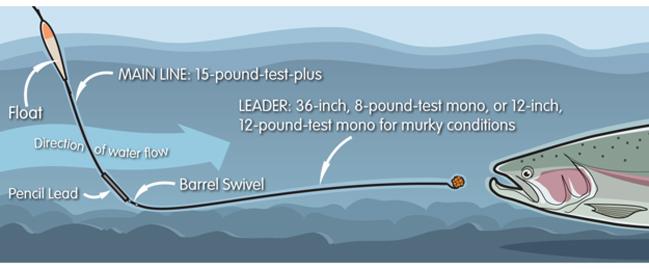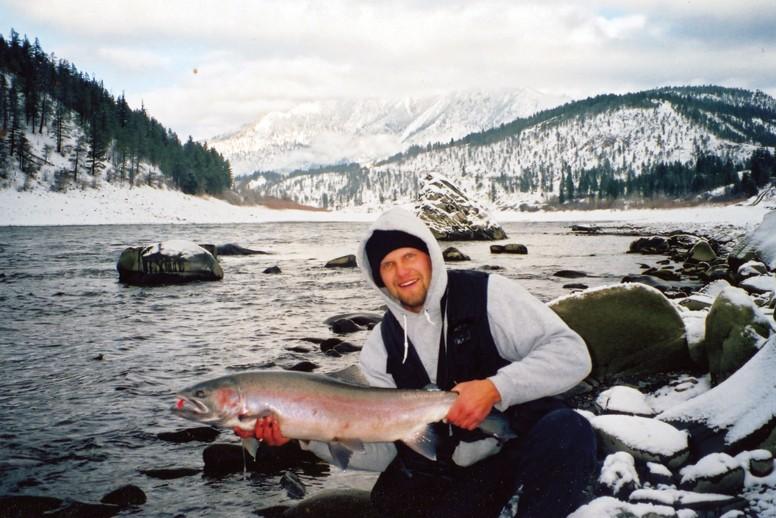Advertisement
Steelhead, they say, are fish of 1,000 casts. And while I’ve never stopped to tally up my casts, I know it certainly helps to enjoy the act of fishing as much as the act of catching in order to be counted as a steelhead angler. But to be counted as a winter steelhead angler, you must also be impervious to numbingly cold water, icy shorelines and sleet—or worse. And, of course, you must have faith that, provided you do everything right, there will come that electrifying moment when the line stops its mesmerizing drift and tightens up against the weight of a fish.
An anadromous evolution of rainbow trout, B.C.’s steelies begin to nose into rivers in early summer, when the snowmelt from the high country begins to swell the flows. These are the summer-run fish, and their numbers grow with every rise in the water. Come late November and early December, however, the winter-run steelhead start entering the rivers, continuing to trickle in right through to the early-spring spawning period.
Advertisement
And because winter steelies have been gorging themselves for an additional six months out in the ocean, they are that much bigger, longer and stronger than their summer-run siblings. Despite water temperatures just shy of freezing, winter steelhead are also more aggressive, making them great sport on the end of the line.
When to fish:
Any time the rivers are in good shape and the thermometer lingers above freezing is a good time to be fishing for winter steelhead. The first few hours following a particularly high tide will mark the arrival of fresh fish from the ocean; rising water will also wake up fish already in the pools.
Advertisement
On southern rivers, frequent downpours will blow out the rivers for weeks on end, but if you can be there when the water recedes, the odds of hooking up on a fresh run are better than average. On northern rivers, mild weather in the mountains can also blow out rivers with runoff; watch for cold nights, which tend to stem the flow.
Start with a short cast slightly upstream and maintain a straight line between the rod tip and the float without restricting the free float of the rig. Let it drift downstream through the holding water to the end of the pool or until you can no longer control the drift and maintain an effective presentation. Then, pick up and cast a bit farther across and repeat.
Advertisement
Keeping a straight line to the rig requires practice. If the running line is slack, the float tends to drift ahead of the bait, making it impossible to get a good hookset. If the running line is cinched too tight, however, it slows the natural drift of the float, allowing the current to carry the leader and hook up out of the strike zone.
The drift and the action of the float are indicators of what’s going on at the terminal end. Watch closely for any change in the rate of the drift, or for the float to dip into the water, submerge completely or rise unnaturally. Any of these indicators could signal a strike—or a snag. If your running line is straight to the float, it’s simply a matter of raising the rod tip slightly to find out. But if the running line is slack, you’ll miss an awful lot of fish—and that’s definitely not worth freezing for.
How to fish:
Start with a short cast slightly upstream and maintain a straight line between the rod tip and the float without restricting the free float of the rig. Let it drift downstream through the holding water to the end of the pool or until you can no longer control the drift and maintain an effective presentation. Then, pick up and cast a bit farther across and repeat.
Keeping a straight line to the rig requires practice. If the running line is slack, the float tends to drift ahead of the bait, making it impossible to get a good hookset. If the running line is cinched too tight, however, it slows the natural drift of the float, allowing the current to carry the leader and hook up out of the strike zone.
The drift and the action of the float are indicators of what’s going on at the terminal end. Watch closely for any change in the rate of the drift, or for the float to dip into the water, submerge completely or rise unnaturally. Any of these indicators could signal a strike—or a snag. If your running line is straight to the float, it’s simply a matter of raising the rod tip slightly to find out. But if the running line is slack, you’ll miss an awful lot of fish—and that’s definitely not worth freezing for.
What to fish:
That steelhead will move to a lure at all in this numbingly cold water is remarkable, yet move they do, occasionally snatching some morsel from the flow. But they rarely venture far from their lies to do so. As such, the secret is to drift your presentation a hand’s width off the bottom.
Drifting bait under a float is often the most productive tactic, probably because the offering can be worked through the lies more efficiently than a swung fly. The set-up consists of a float, a piece of pencil lead—heavy enough to submerge all but an inch of the float—and a three-foot, six- to eight-pound-test monofilament leader tied onto a size 4, octopus-style steelhead hook (see diagram below). Use heavier, shorter leaders and larger hooks in low light or coloured water.
For bait, artificial eggs—clusters or singles—work well, as do pink worms, yarn and Spin-N-Glos. Where permitted, cured roe and ghost shrimp often produce better than artificials. As for gear, a 12- or 13-foot rod is typically used, although I’ve also seen 14-footers. And while a free-spooling centre pin reel is best, a level-wind reel can work, too.

For some of the top spots to fish winter steelhead in B.C., check out this article.

